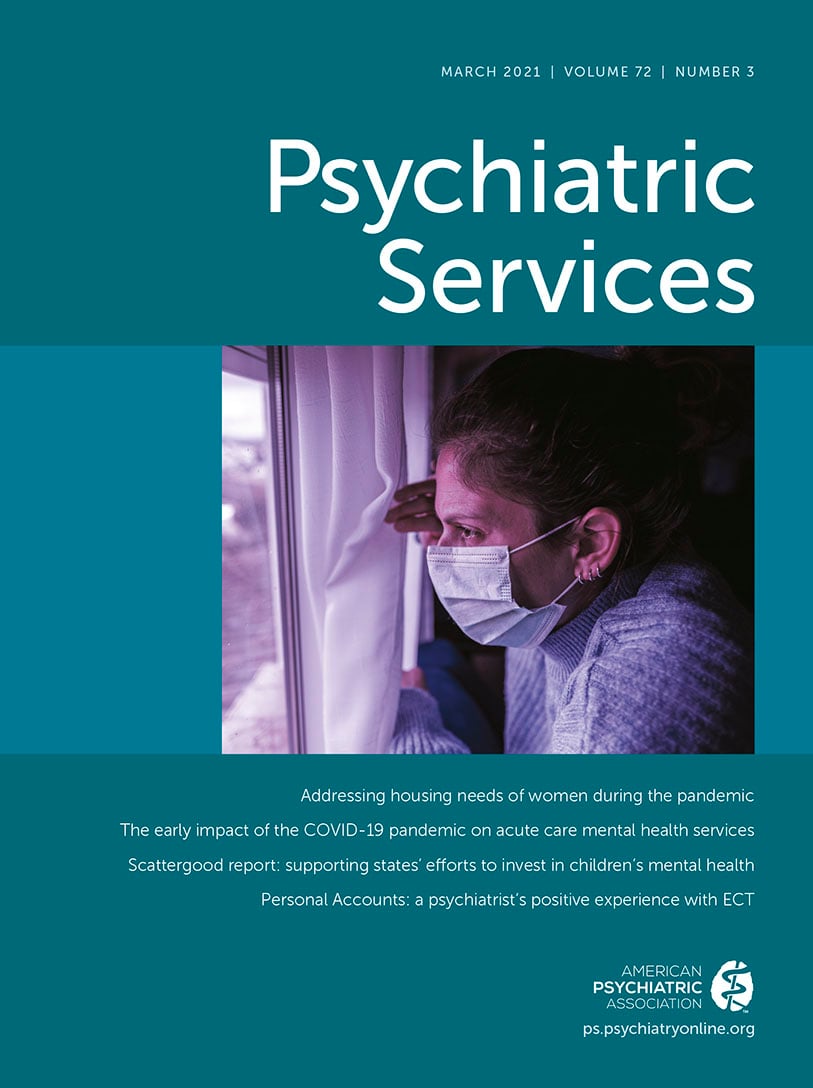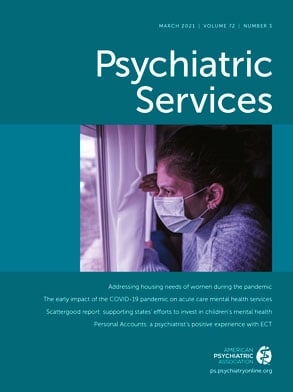Homelessness is a serious and poorly addressed social problem. It is estimated that in the United States, 552,830 people experienced homelessness on any given night in 2018, of whom 7% were youths ages <25 years (
1). Although the U.S. Department of Housing and Urban Development reports that homelessness rates overall have been decreasing in the past decade, this decrease has been much slower among youths, who often experience significantly higher rates of mental disorders that contribute to unremitting homelessness (
1,
2).
Efforts to address homelessness require modifications to existing treatment frameworks to improve access but also policy changes at the individual, local, state, and federal levels. We conducted a literature review in consultation with a medical librarian, performed focused searches, and drew on our own expert knowledge. This process was initiated for a policy paper written for the National Association of State Mental Health Program Directors. This article summarizes key literature on the mental health needs of youths who are homeless and the interventions developed to date, highlights novel approaches to increasing access to mental health services for this population, and suggests policy changes that may help to facilitate the dissemination of these therapeutic approaches.
Existing Behavioral and Mental Health Interventions for Homeless Youths
It is important to explore the benefits of empirically supported treatments for the population of youths who are homeless so that future recommendations for intervention are thoroughly supported by psychological theory and rigorous examination. One area of intervention for youths who are homeless prioritizes engagement of the family system. To date, six clinically effective family-based interventions supported by randomized controlled trial data have been identified: ecologically based family therapy (EBFT), functional family therapy (FFT), multidimensional family therapy (MFT), multisystemic therapy (MST), Treatment Foster Care Oregon (TFCO), and support to reunite, involve, and value each other (STRIVE) (
39). Each intervention includes four core components that are likely essential to their efficacy: providing the services within the home; offering clinical services in conjunction with parent training; the inclusion of multiple, intensive sessions; and the use of graduate-level therapists.
Evaluations of these trauma-informed family interventions suggest that they show promise in reducing risk behaviors among homeless youths, although the specific intervention targets have varied (
39). For instance, EBFT, FFT, and STRIVE have focused on family functioning, with specific emphasis on strengthening positive family interactions through communication and problem-solving skills. In contrast, MFT, MST, and TFCO target specific populations and risk behaviors: adolescent substance use, delinquency, and foster families, respectively. Overall, studies evaluating family-based interventions in this population suggest that multisystemic approaches yield positive behavioral outcomes in homeless youths.
Because family-based interventions are not always feasible, individual-level interventions have been developed, but clinical outcome data on these latter interventions are much more varied. For example, although brief motivational interviewing has shown success in the treatment of substance use disorders in traditional clinical settings, two evaluations of this intervention suggest that it is not the most effective for reducing substance use among homeless youths (
40). Peterson et al. (
41) found that although illicit drug use was reduced after homeless youths participated in a brief, three-session motivational interviewing intervention, compared with a control group of homeless youths not receiving this intervention, this outcome did not persist at a 3-month follow-up. Uses of marijuana and alcohol, two of the most frequently used substances in this population, were also not reduced (
42). A slight modification of this program, which included an additional treatment session, did result in decreased alcohol and marijuana use, but no significant difference between the treatment and control groups was detected (
43).
Behaviorally focused approaches appear to yield better long-term clinical outcomes as measured by self-reported reductions in substance use. Using a community reinforcement approach (CRA), which relies on principles of operant conditioning to increase social rewards for sober activities, Slesnick and colleagues (
44) found that 12 CRA sessions, coupled with four sessions of HIV education and skill practice, led to self-reported reductions in the number of days of drug use and of drugs used among youths residing in shelters. The addition of case management to CRA significantly decreased drug and alcohol use at 12 months (
45), but the number of sessions did not predict the rate of behavioral change. Furthermore, the effectiveness of these models has been challenging to gauge, given the numerous confounding factors that are difficult to control in the designs. In one study, daily drug screening and intensive individual counseling resulted in a large drop in drug dependence among homeless youths, but the long-term success of this approach has not been determined (
46). Others have found that, when health resources and skills training are included in traditional shelter-based care, female youths are more likely than male youths to have reduced substance misuse (
47). The literature on interventions for risky sexual behavior has suggested a similar moderating effect of gender, suggesting an emphasis on developing gender-specific interventions for high-risk populations of homeless youths (
48).
However, simply providing youths with access to treatment services through shelter systems does not appear to reduce high-risk behavior long term (
49,
50). In fact, when traditional drop-in center access was paired with vocational training, supportive mentorship, and clinical services, youths exhibited improvements in self-reported mental health outcomes but also increases in risky behaviors (i.e., drug use and number of sexual partners) (
51).
Despite the wide range of psychopathology seen in this population, most research has focused on risky sex and drug use, with mental health sequalae (e.g., depression and anxiety symptoms) regarded as secondary outcomes. In addition, very limited research has been conducted within the past 10 years on addressing mental health disparities in homeless youths, and it is difficult to draw comparisons across studies given a wide variability in both the methodology and theoretical underpinnings of the evaluated intervention frameworks (
52,
53). A further limitation of these interventions is the high participant attrition rate, which makes longitudinal assessment challenging. Again, however, these treatment models are still complicated by low retention, and, in some cases, no differences between control and treatment groups were observed (
54–
56). Finally, even when longitudinal follow-up is done as part of the intervention, these program components are difficult and often costly to sustain. This further highlights the need to find novel approaches for dissemination and implementation of services for this population.
Policy Implications and Suggestions for Governmental Influence on Research That Concerns Homeless Youths
The research and interventions outlined here have significant policy implications. Much has been learned regarding the challenges of providing services to youths who are homeless, and there is certainly more to learn. The following discussion highlights several critical areas that should be addressed through policy-level approaches at each government branch.
Local governments have generally focused on creating shelter spaces for homeless youths. This priority should remain, with the modification that local governments should be discouraged from using vagrancy laws to drive homeless individuals out of communities. In tandem with these approaches, local governments could encourage peer-driven interventions and provide services that engage homeless youths to better support one another.
State and federal governments provide the major share of funding to support interventions for homeless youths. Therefore, state and federal laws would benefit from greater consistency in the definition of homelessness and the age of majority for decision making, both of which vary dramatically by state. Technology interventions would also benefit from consistency of laws across state lines. For example, telehealth laws and policies also vary dramatically by state, and restrictions on interstate practice create hurdles to working with homeless youths who may regularly cross state lines.

